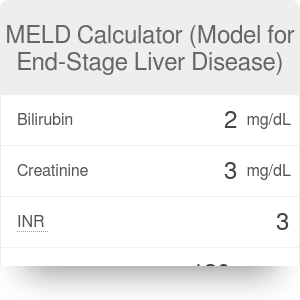

- #Meld score calculator for liver transplant how to#
- #Meld score calculator for liver transplant series#
"The MELD-Plus: A generalizable prediction risk score in cirrhosis".
#Meld score calculator for liver transplant series#
It was derived in a series of patients undergoing TIPS procedures. Patrick Kamath, and at that point was called the "Mayo End-stage Liver Disease" score. MELD was originally developed at the Mayo Clinic by Dr. Patients with MELD scores greater than 24 who are reasonable liver transplant candidates are probably best served by foregoing TIPS placement.The best outcomes with TIPS occur among patients with a MELD score less than 14.The OPTN waiting list at 2A or 2B status between November, 1999, and December, 2001) is: MELD score In interpreting the MELD Score in hospitalized patients, the 3 month observed mortality (considering 3,437 adult liver transplant candidates with chronic liver disease who were added to Patients with a diagnosis of liver cancer will be assigned a MELD score based on how advanced the cancer is. Modification of the MELD score by excluding etiology of liver disease did not significantly affect the model's accuracy in predicting three-month survival.
#Meld score calculator for liver transplant how to#
The etiology of liver disease was subsequently removed from the model because it posed difficulties such as how to categorize patients with multiple causes of liver disease. if bilirubin is 0.8 a value of 1.0 is used) to prevent subtraction from any of the three factors, since the natural logarithm of a positive number below 1 (greater than 0 and less than 1) yields a negative value.

Any value less than one is given a value of 1 (i.e.If the patient has been dialyzed twice within the last 7 days, then the value of serum creatinine should be 4.0 mg/dL.UNOS has made the following modifications to the score: MELD scores are reported as whole numbers, so the result of the equation above is rounded. It is calculated according to the following formula: MELD = 3.78×ln + 11.2×ln + 9.57×ln + 6.43 MELD uses the patient's values for serum bilirubin, serum creatinine, and the international normalized ratio for prothrombin time (INR) to predict survival. This score is now used by the United Network for Organ Sharing (UNOS) and Eurotransplant for prioritizing allocation of liver transplants instead of the older Child-Pugh score. It was initially developed to predict mortality within three months of surgery in patients who had undergone a transjugular intrahepatic portosystemic shunt (TIPS) procedure, and was subsequently found to be useful in determining prognosis and prioritizing for receipt of a liver transplant. The Model for End-Stage Liver Disease, or MELD, is a scoring system for assessing the severity of chronic liver disease. Scoring system for assessing the severity of chronic liver disease Model for End-Stage Liver DiseaseĪssess the severity of chronic liver disease


 0 kommentar(er)
0 kommentar(er)
